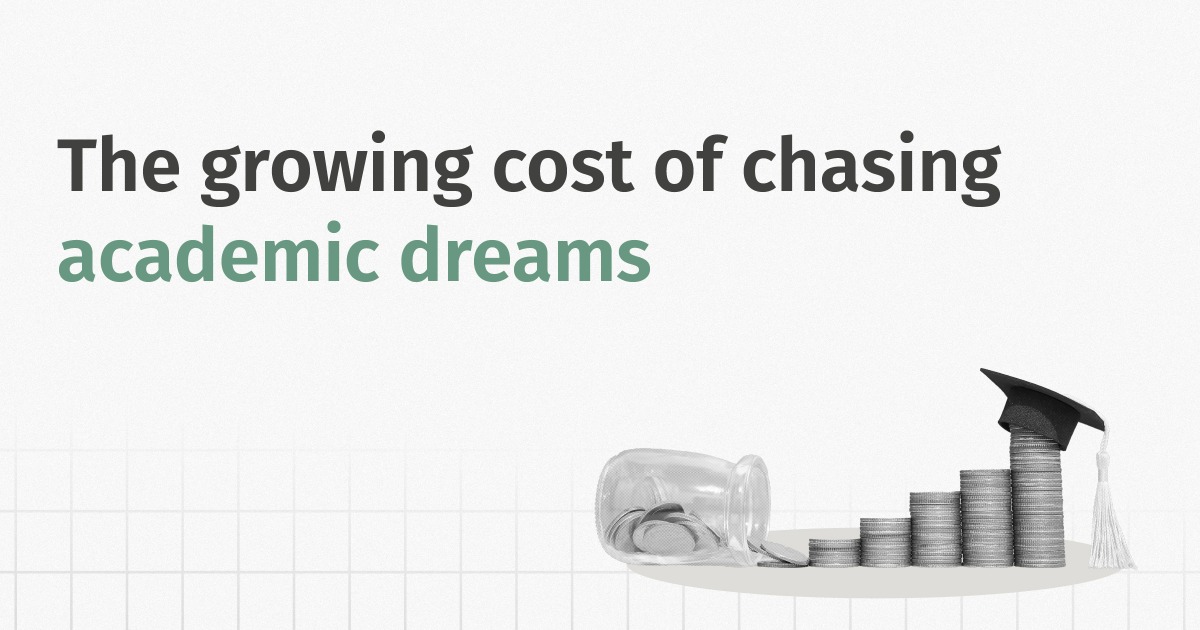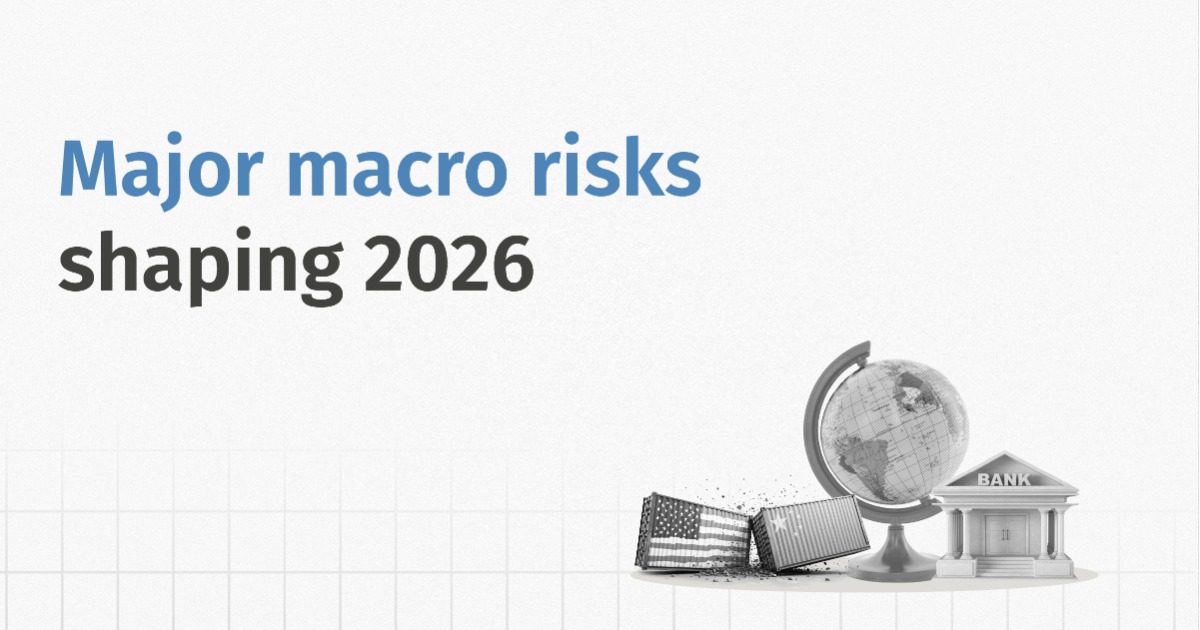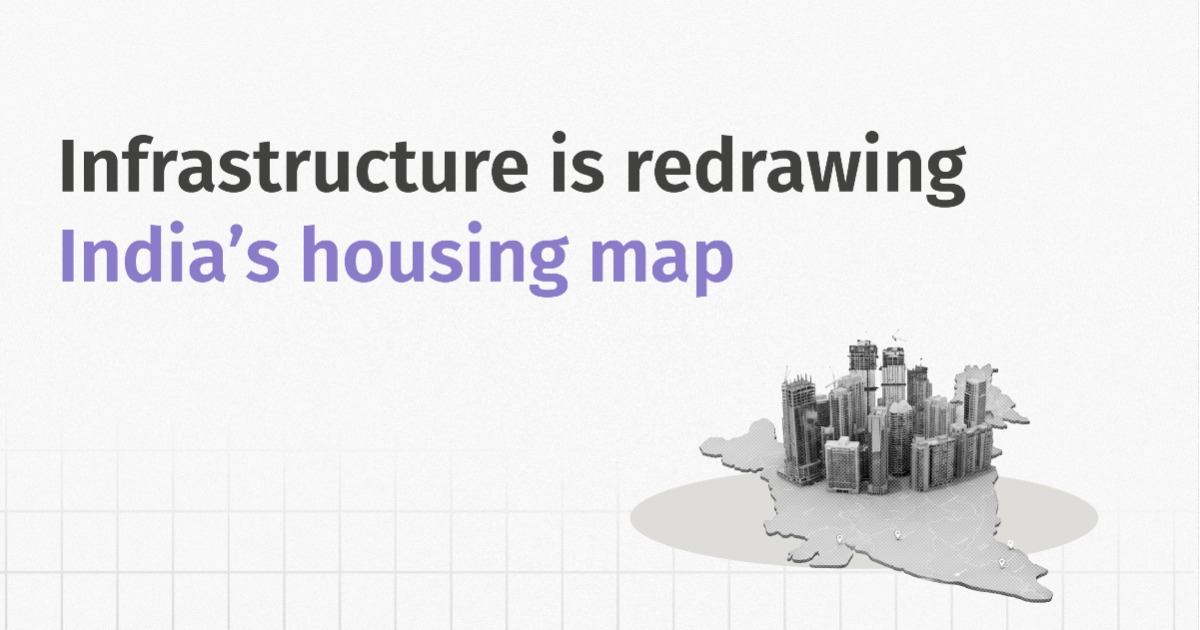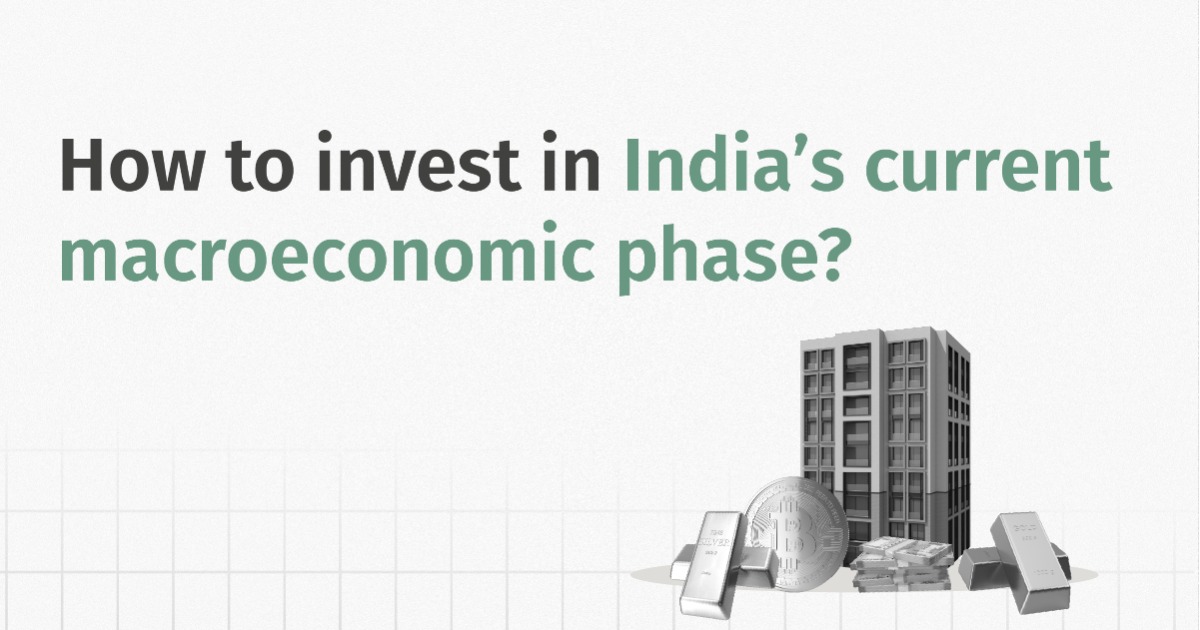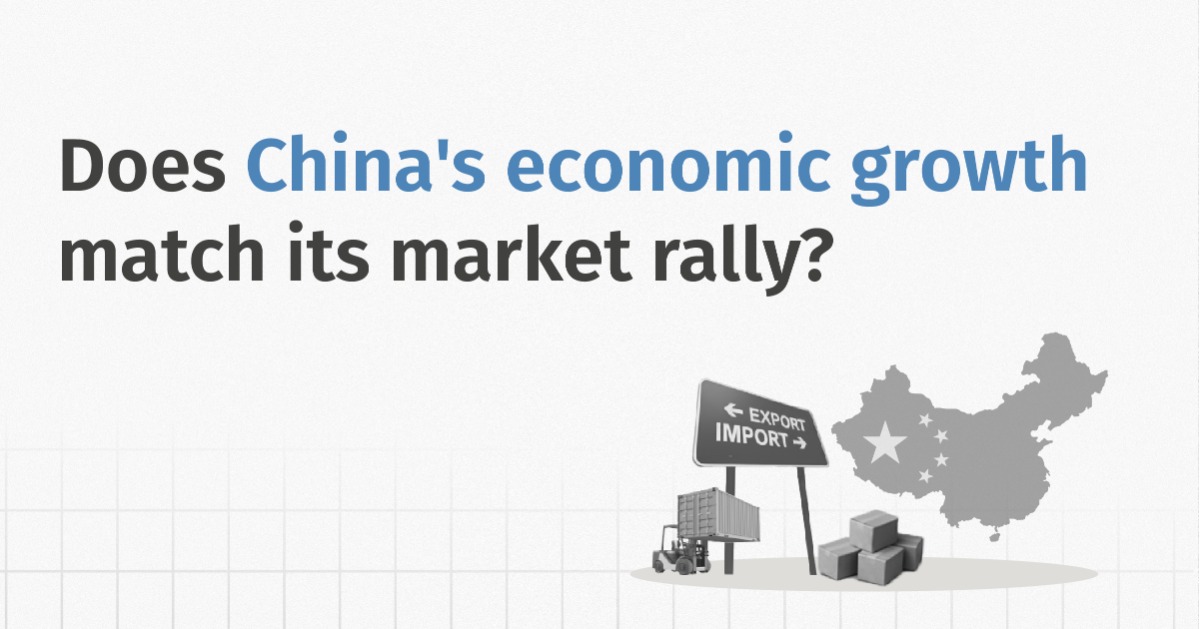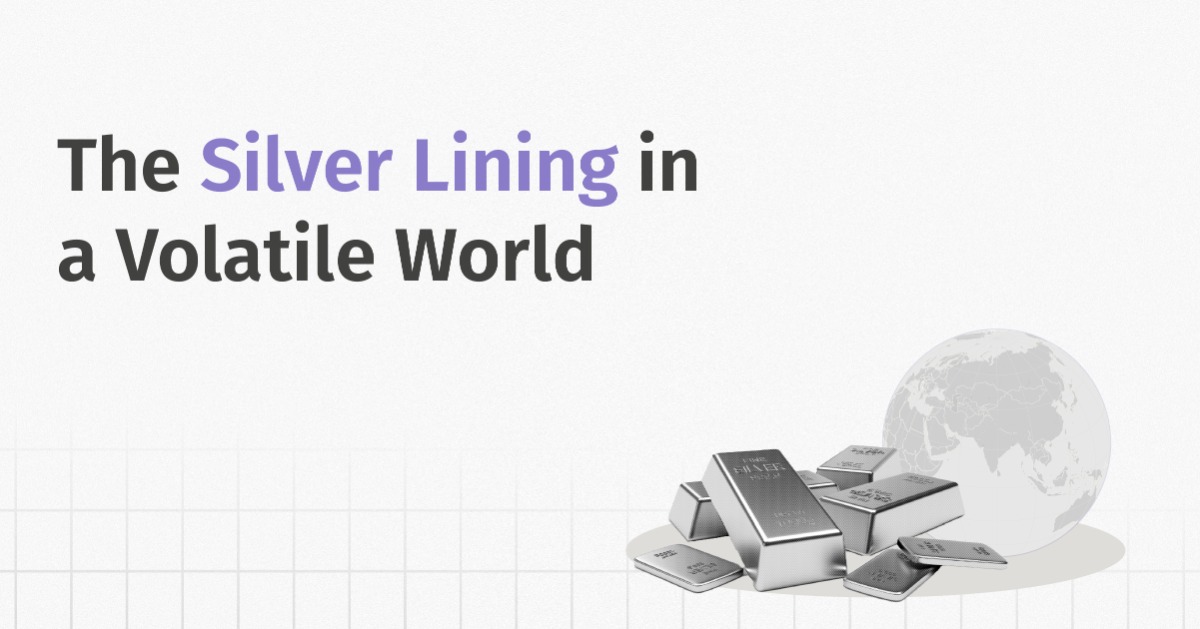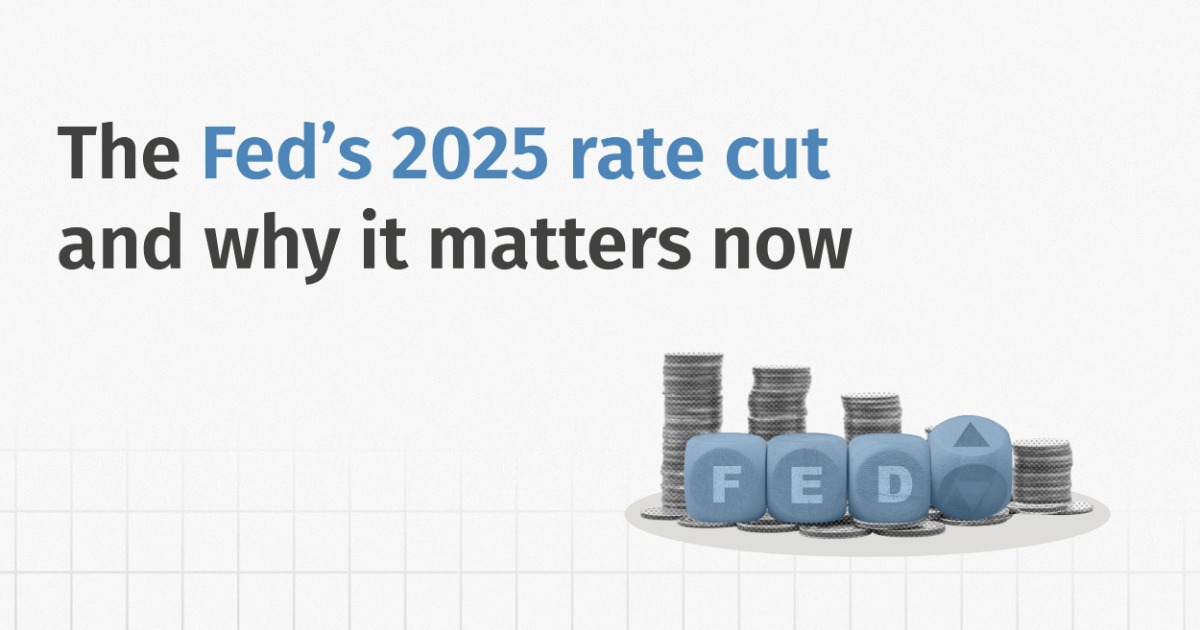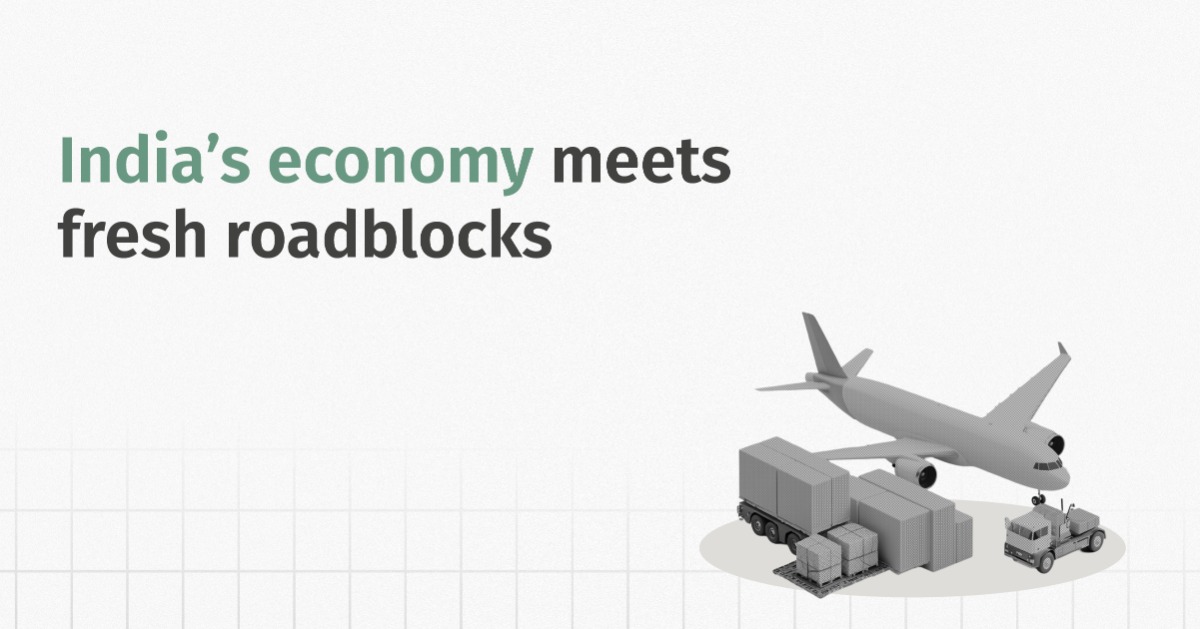After exploring the rising costs of school and undergraduate education, we now turn to postgraduate studies: the final stretch of India’s academic journey. This third part of our series examines how tuition, accommodation, and mess fees have evolved across government and private institutions, and what the numbers reveal about education inflation at the postgraduate level.
Our earlier analyses showed school fees rising 10-12% annually and undergraduate costs up 7-15%, especially in private institutions, highlighting how education inflation in India is consistently outpacing both general inflation and household income growth.
Postgraduate education has long been viewed as a ladder to professional success, a bridge between aspiration and opportunity. However, in recent years, that bridge has become steeper and more costly. Across disciplines, the cost of advanced degrees has risen faster than household incomes or general inflation, making affordability a significant concern for students and families alike.
Note: This analysis draws from the fee structures of 80 government and private institutions across 40 cities in India.
Medical & Healthcare
India’s postgraduate medical education is now a tale of two worlds. The gulf between government and private colleges has grown so wide, it’s hard to ignore: while a 3-year degree at a government institution costs roughly ₹2.1 lakh, private colleges demand an eye-watering ₹51.8 lakh, almost 25 times higher.
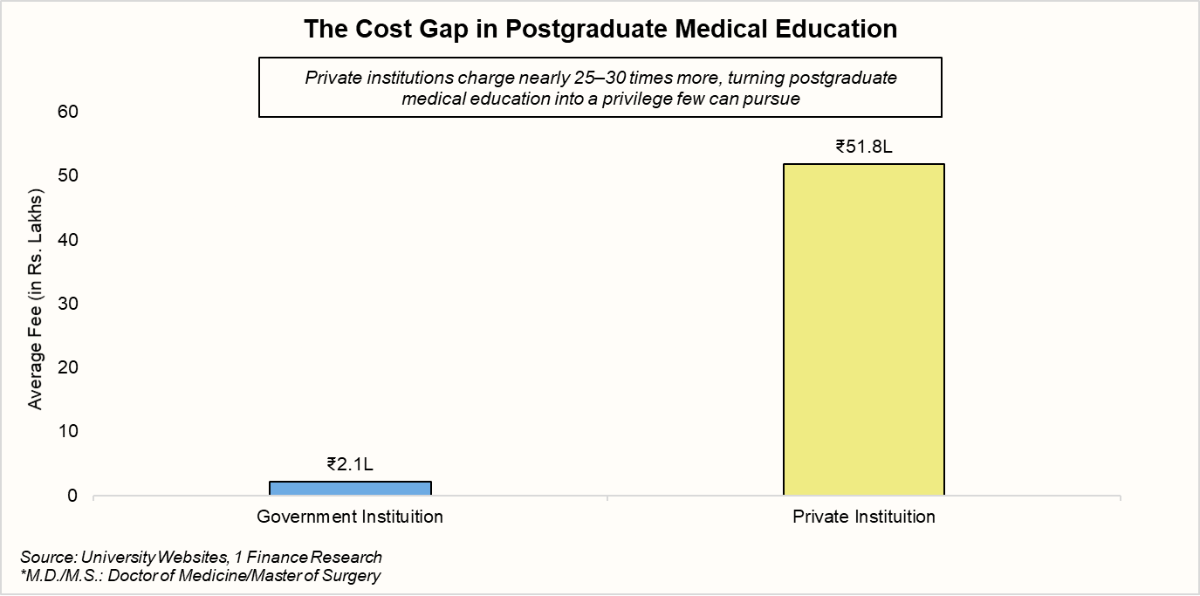
Commerce & Management
Management education has become a powerful symbol of ambition and expense. The fee gap is hard to miss: top government MBA/PGDM programs cost about ₹16 lakh for a 2-year degree, while leading private business schools now command a jaw-dropping ₹25.7 lakh, over 60% higher.
Even at the M.Com level, the difference is no less stark. Government colleges charge just ₹0.5 lakh, but private institutions ask ₹2.2 lakh, more than four times as much.
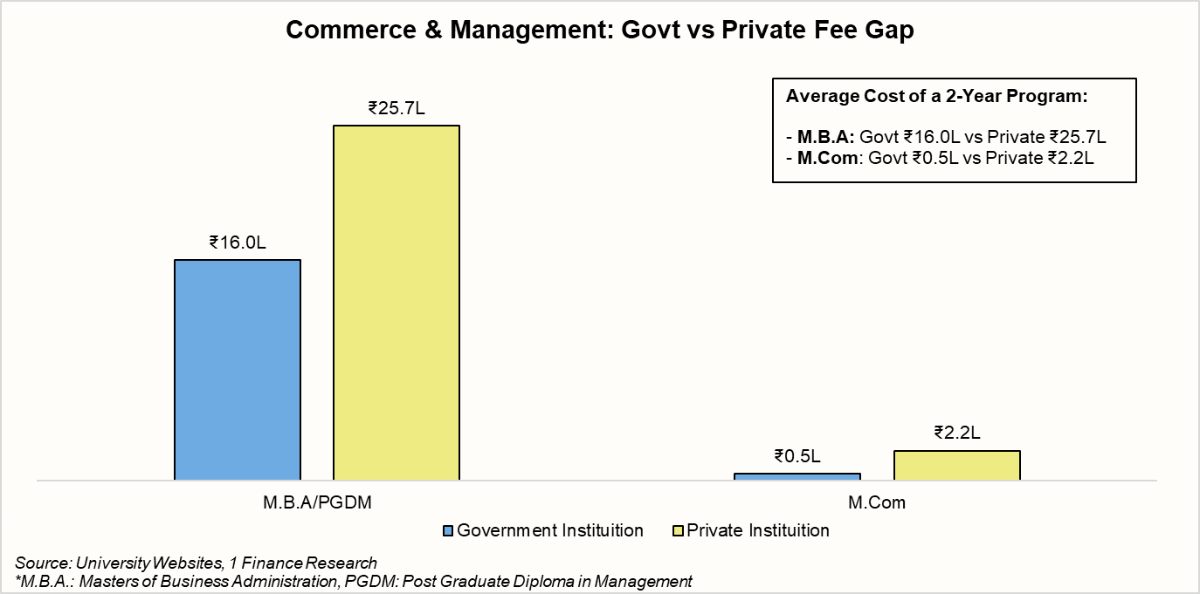
Science & Technology
Science and technology courses present a picture that’s anything but uniform. For a 2-year MCA, private colleges charge ₹4.1 lakh, more than double the ₹1.8 lakh in government-run programs. The fee gap for M.Sc. is just as stark, with private institutions at ₹2.9 lakh compared to ₹0.9 lakh in the public sector.
M.Tech, interestingly, breaks the trend with near parity: both private and government institutions hover around ₹1.3–1.4 lakh. But for most, whether in computer applications or science, private options now command a substantial premium. The “tech premium” is real and growing.
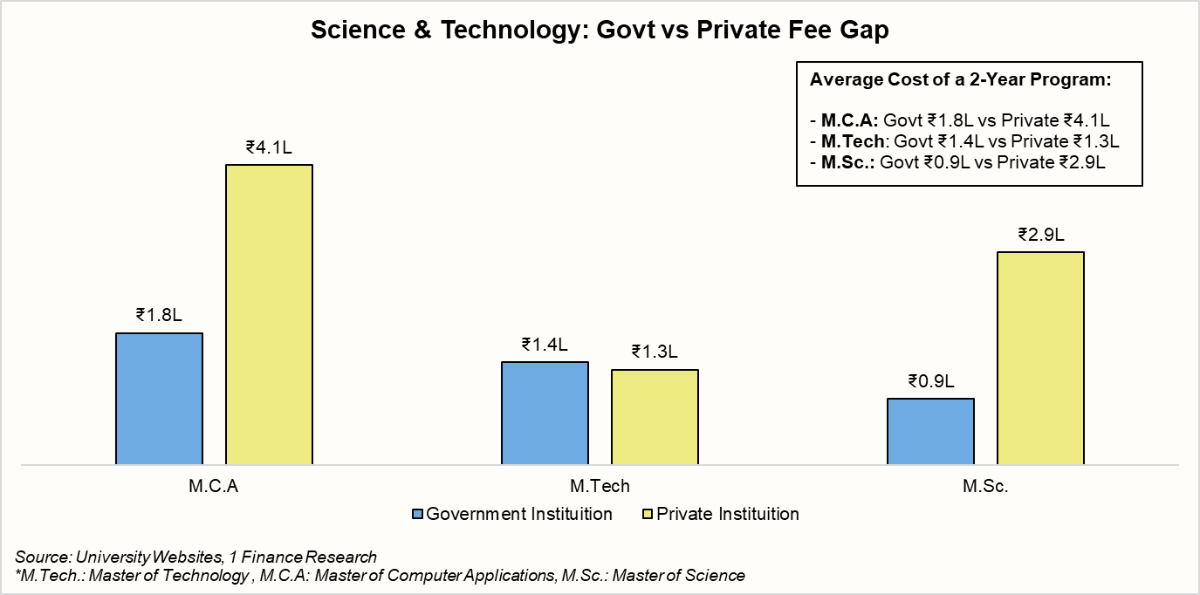
Humanities, Law & Design
In humanities, law, and design, the shifting cost landscape is clear and concerning. Private Master of Design (M.Des) programs charge over twice what government institutions do: ₹8.4 lakh versus ₹3.7 lakh annually. For the Master of Arts (M.A.), the fee difference is even more pronounced: ₹4.2 lakh in private colleges compared to just ₹0.4 lakh in government ones.
Law programs, too, carry a premium, albeit narrower. The average L.L.M. fees stand at ₹2.4 lakh in private and ₹2.0 lakh in government institutions. The once-affordable streams are no longer immune to surging fees, making affordability tougher to find.
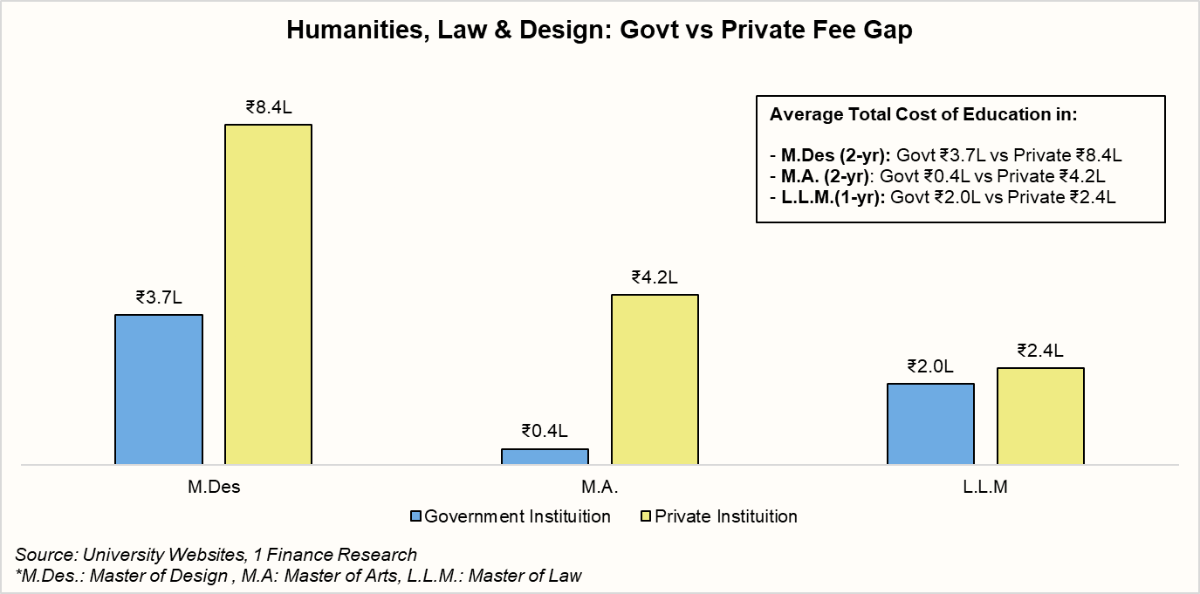
Rising Education Inflation in India’s Postgraduate Courses
Now that the costs are clear, what inflation number should one plan for? Well, it really depends, because analysis reveals a wild disparity. Annual fee hikes can be as low as 1% at institutions like IIT Bombay and Amity University for M.Tech and M.Sc., but they can aggressively climb to 23% at Shrishti Manipal Institute for M.Des. While private institutions show a higher concentration of hikes above the 5% mark, government colleges also feature high outliers, proving high inflation isn't sector-exclusive. The biggest risk is the lack of a consistent standard across the board.
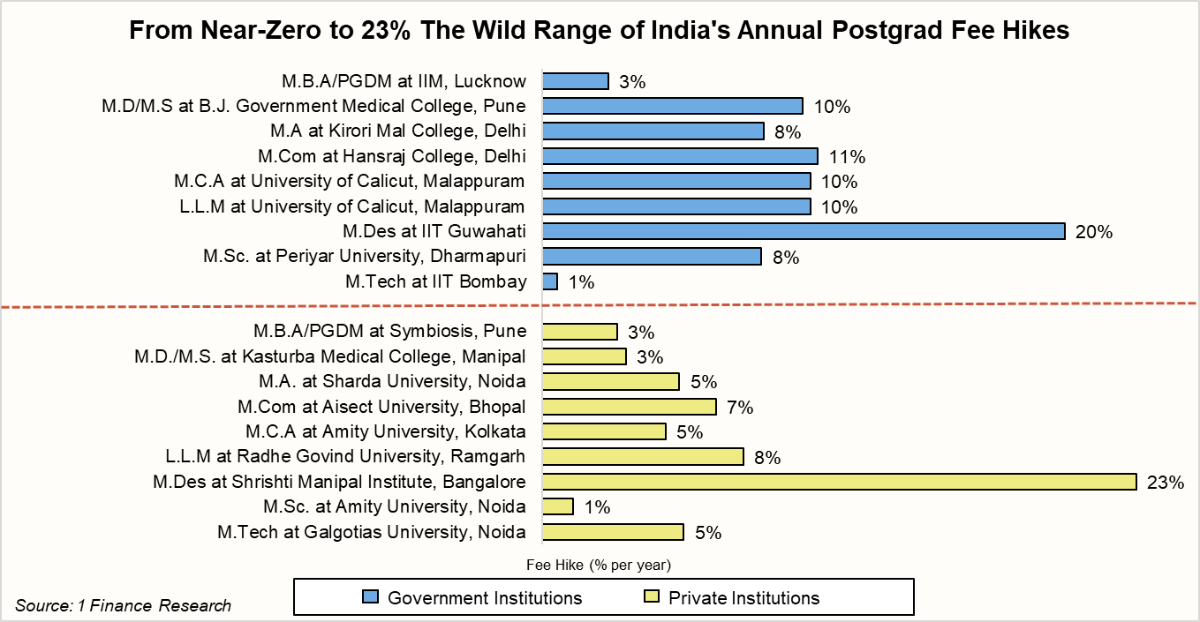
Note: Inflation rates shown are calculated based on changes in published fee structures across different postgraduate courses. Comparisons were made between earlier academic years (e.g., 2022-23 or 2023-24) and subsequent years (e.g., 2024-25 or 2025-26), depending on data availability.
Given the immense 1% to 23% range, planning must be institute-specific. Use the historical fee hike of the target institution, or conservatively plan with an 8% annual fee inflation, reflecting the most common hike percentage across the board.
Surviving Campus Life Without Going Broke
While tuition grabs headlines, the real silent burden is living costs: accommodation and mess fees that often rival classroom expenses.
Some top campuses, even government institutions, can demand hefty living costs. For instance, IIM Bangalore tops our list with annual living expenses of ₹4.2 lakh, followed closely by International Management Institute, Delhi at ₹4.0 lakh. Even public universities aren’t immune, with several reporting hostel and meal plans that outpace expectations.
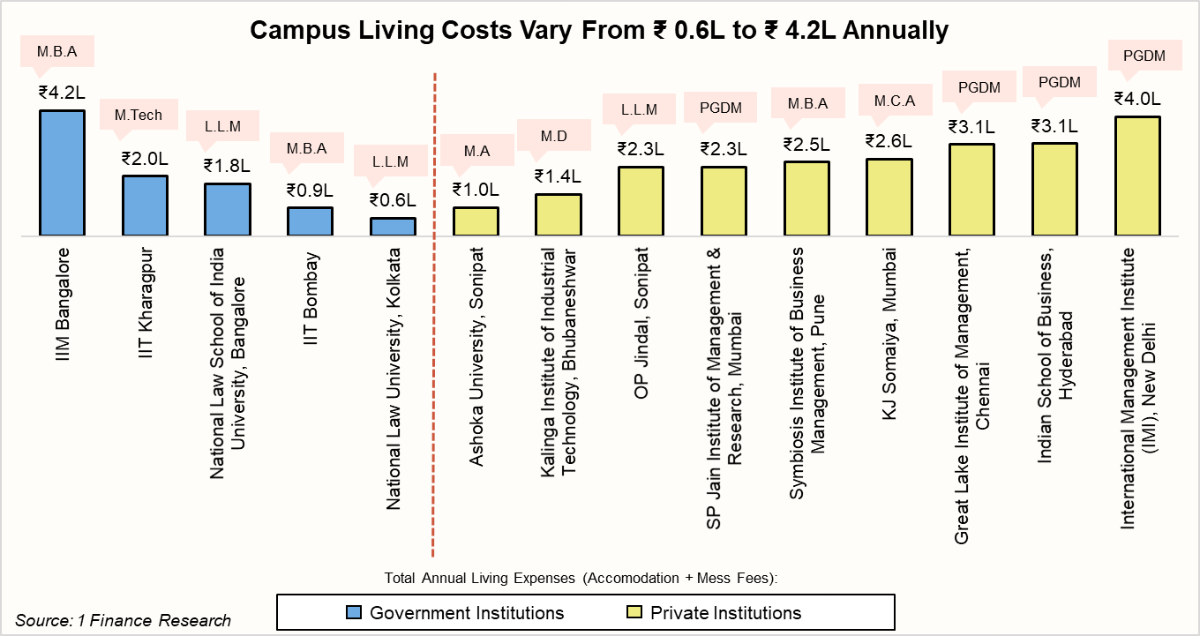
Note: The chart details the annual costs for student accommodation and mess facilities at both government and private institutions, as applicable to the 2025-26 academic year. The figures represent total living expenses for enrolled students, based on current published rates.
Now, the real question: how much of the total postgraduate bill goes into living expenses? The data reveals some surprising patterns. The ratio of living costs to total costs varies dramatically. At IMI Delhi, accommodation and food account for 38% of total fees; at Great Lakes, Chennai, 28%; at OP Jindal’s LLM program, just 5%; and at NLS Bangalore, 37%.
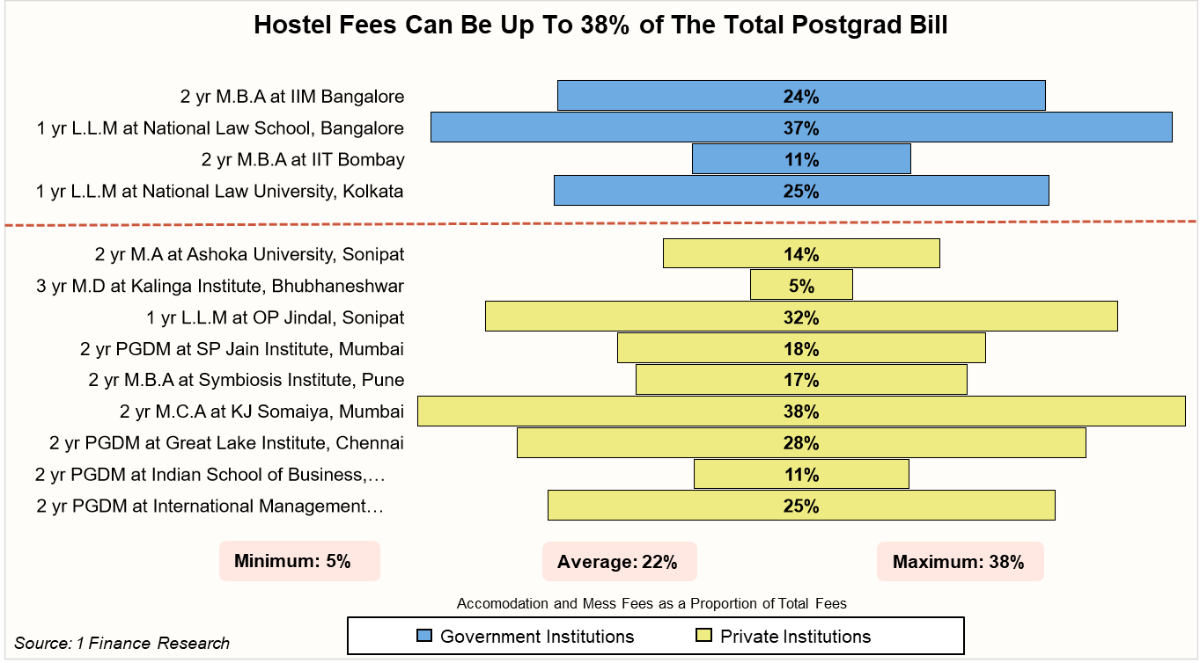
Note: The chart shows accommodation and mess fees as a percentage of the total fee. The total fee is the sum of the accommodation and mess fees plus the tuition fees.
Tuition is only part of the story. Living expenses can significantly impact the total budget, making it essential to include both tuition and accommodation costs when planning.
The Postgrad Payer’s Takeaway
- Postgraduate education costs in India span a wildly varied spectrum. Tuition spans from an affordable ₹0.4 lakh (for M.A. in a government college) all the way up to a staggering ₹51.8 lakh (for M.D./M.S. in a private institution).
- Moreover, inflation is an unpredictable element; it varies widely with no clear pattern. The safe move is to plan with an 8-10% annual inflation rate for Indian postgrad courses.
- Crucially, don't forget the living costs! When students move away to top colleges, accommodation and mess fees become significant, averaging 22% of the total postgraduate bill.
The Bottom Line: Education planning isn’t a one-time task, and the fees usually depend on the demand for the course. Usually, high-demand courses see high inflation. Given the high variability, revisit and adjust the financial projections every 2-3 years to reflect actual fee hikes and evolving academic ambitions. Taken together, overall education inflation now averages around 10-12% annually across all levels. The plan must be as dynamic as the market.
